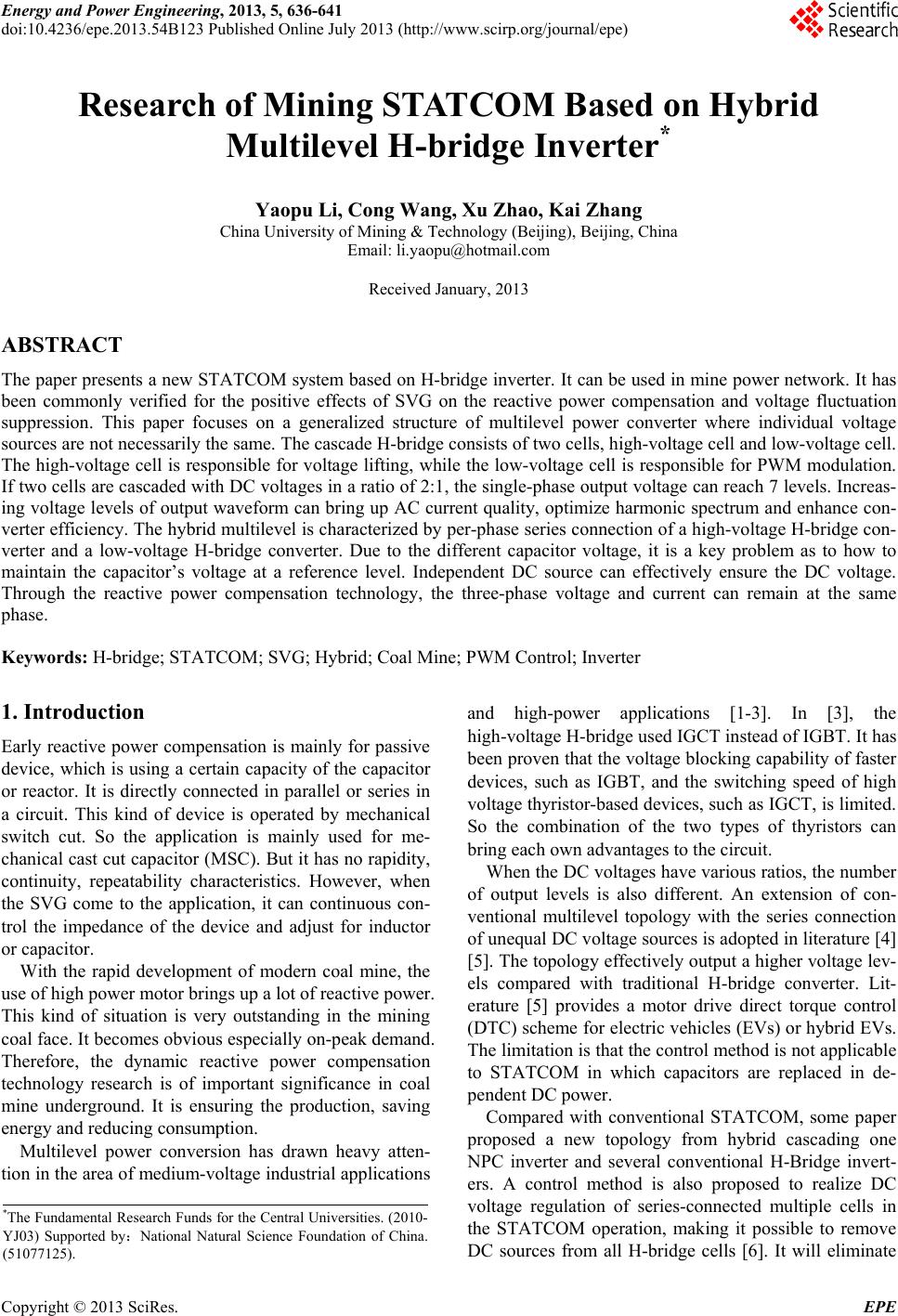
Energy and Power Engineering, 2013, 5, 636-641
doi:10.4236/epe.2013.54B123 Published Online July 2013 (http://www.scirp.org/journal/epe)
Research of Mining STATCOM Based on Hybrid
Multilevel H-bridge Inverter*
Yaopu Li, Cong Wang, Xu Zhao, Kai Zhang
China University of Mining & Technology (Beijing), Beijing, China
Email: li.yaopu@hotmail.com
Received January, 2013
ABSTRACT
The paper presents a new STATCOM system based on H-bridge inverter. It can be used in mine power network. It has
been commonly verified for the positive effects of SVG on the reactive power compensation and voltage fluctuation
suppression. This paper focuses on a generalized structure of multilevel power converter where individual voltage
sources are not necessarily the same. The cascade H-bridge consists of two cells, high-voltage cell and low-voltage cell.
The high-voltage cell is responsible for voltage lifting, while the low-voltage cell is responsible for PWM modulation.
If two cells are cascaded with DC voltages in a ratio of 2:1, the single-phase output voltage can reach 7 levels. Increas-
ing voltage levels of output waveform can bring up AC current quality, optimize harmonic spectrum and enhance con-
verter efficiency. The hybrid multilevel is characterized by per-phase series connection of a high-voltage H-bridge con-
verter and a low-voltage H-bridge converter. Due to the different capacitor voltage, it is a key problem as to how to
maintain the capacitor’s voltage at a reference level. Independent DC source can effectively ensure the DC voltage.
Through the reactive power compensation technology, the three-phase voltage and current can remain at the same
phase.
Keywords: H-bridge; STATCOM; SVG; Hybrid; Coal Mine; PWM Control; Inverter
1. Introduction
Early reactive power compensation is mainly for passive
device, which is using a certain capacity of the capacitor
or reactor. It is directly connected in parallel or series in
a circuit. This kind of device is operated by mechanical
switch cut. So the application is mainly used for me-
chanical cast cut capacitor (MSC). But it has no rapidity,
continuity, repeatability characteristics. However, when
the SVG come to the application, it can continuous con-
trol the impedance of the device and adjust for inductor
or capacitor.
With the rapid development of modern coal mine, the
use of high power motor brings up a lot of reactive power.
This kind of situation is very outstanding in the mining
coal face. It becomes obvious especially on-peak demand.
Therefore, the dynamic reactive power compensation
technology research is of important significance in coal
mine underground. It is ensuring the production, saving
energy and reducing consumption.
Multilevel power conversion has drawn heavy atten-
tion in the area of medium-voltage industrial applications
and high-power applications [1-3]. In [3], the
high-voltage H-bridge used IGCT instead of IGBT. It has
been proven that the voltage blocking capability of faster
devices, such as IGBT, and the switching speed of high
voltage thyristor-based devices, such as IGCT, is limited.
So the combination of the two types of thyristors can
bring each own advantages to the circuit.
When the DC voltages have various ratios, the number
of output levels is also different. An extension of con-
ventional multilevel topology with the series connection
of unequal DC voltage sources is adopted in literature [4]
[5]. The topology effectively output a higher voltage lev-
els compared with traditional H-bridge converter. Lit-
erature [5] provides a motor drive direct torque control
(DTC) scheme for electric vehicles (EVs) or hybrid EVs.
The limitation is that the control method is not applicable
to STATCOM in which capacitors are replaced in de-
pendent DC power.
Compared with conventional STATCOM, some paper
proposed a new topology from hybrid cascading one
NPC inverter and several conventional H-Bridge invert-
ers. A control method is also proposed to realize DC
voltage regulation of series-connected multiple cells in
the STATCOM operation, making it possible to remove
DC sources from all H-bridge cells [6]. It will eliminate
*The Fundamental Research Funds for the Central Universities. (2010-
YJ03) Supported by:National Natural Science Foundation of China.
(51077125).
Copyright © 2013 SciRes. EPE